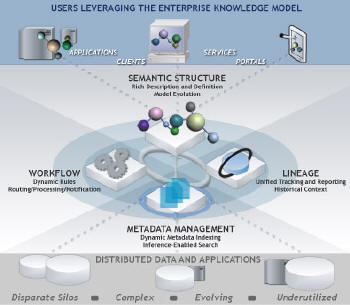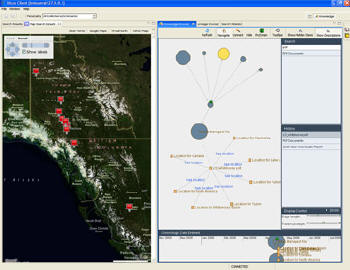 There are
a number of technologies available to support enterprises in their
efforts to more efficiently transition from data to information to
knowledge to actionable understanding. Much has been made in the past
year of the potential of semantic technologies to transform the way
enterprises manage data, information and knowledge. Thetus Corporation is among those
pioneering an approach to this promising technology, with Thetus
Publisher, the company's flagship software product which provides a
framework to model, track and evolve knowledge derived from any variety
of data sources.
There are
a number of technologies available to support enterprises in their
efforts to more efficiently transition from data to information to
knowledge to actionable understanding. Much has been made in the past
year of the potential of semantic technologies to transform the way
enterprises manage data, information and knowledge. Thetus Corporation is among those
pioneering an approach to this promising technology, with Thetus
Publisher, the company's flagship software product which provides a
framework to model, track and evolve knowledge derived from any variety
of data sources.Thetus Publisher provides the necessary functionality to traverse disparate data sources and collect meaningful and useful information, organize the process, and make it repeatable and "tunable" to the individual user's requirements. This lets an enterprise pursue new and existing data and ultimately develop a path to understanding that spans business processes and leverages location intelligence, market insights and a better view of the competitive landscape.
What is Knowledge Modeling?
Not so simply put, knowledge modeling is a systematic approach to understanding, discovering and codifying the information, workflows, history and relationships inherent in today's complex and rapidly changing business environment. More simply put, it can be a virtual map of data relationships or an actual geographic map of the enterprise - one that can addresses the real "what if" questions like "What are our risks?" and "Where should we go next in products, marketing, physical locations?" The answers to these questions ultimately lead to better, more informed decisions through a unified view and understanding of business, location, market and competitive intelligence.
In today's environment where data sources, business processes and systems are complex, highly distributed and evolving, knowledge modeling software can be an asset for companies looking to maintain a competitive edge. The traditional document-centric and relational database approaches to managing data are rooted in thinking of data in terms of files in a cabinet and rows in a ledger. These concepts and tools are not well suited to answering mission-critical questions with speed and efficiency.
Already we are seeing a steady erosion of the traditional information management metaphors in the agile world of consumer Internet applications such as Gmail, blogging sites, tagging services and popular photo management services like flickr provided by Yahoo. Users of these applications are drawn to the ease of use and expressive nature of applications that make it easy to classify data and describe what they are, what they mean and how they relate to other data. You don't see any file folders or boundaries to classification and expression in this world. Certainly the enterprise problem is more complex than consumer email and photo sharing, but large investments in semantic technologies by companies like Microsoft, Yahoo and IBM are strong indications of changes to come.
Building a Map
So how do we bring this same agility to the enterprise? Thetus Publisher is a server-based system that provides management infrastructure for the four core components of a knowledge model: semantic structure, data/metadata, workflow and history. These are the building blocks for a model that is the virtual geography of the enterprise. It shows the current, past and possibly even the future state of the enterprise. Think about the potential of being able to say: "Show me those locations doing over X dollars with Y and Z competitors and with these demographics in natural text and give me the map, the data and anything else that is relative."
 |
Semantic structure consists of the lines, points, polygons and labels of our map of enterprise knowledge. It captures the meaning of the labels and relational geometry and puts them in the user's language. Descriptive terms can evolve through the same dynamic flexibility and expressiveness that drives the Internet 'tag cloud' and they can be guided by standard vocabularies developed for specific disciplines. Users are not forced to adhere to a schema to interact with the data or the model. When a discovery is made, the model evolves to accommodate it. Thetus takes a pragmatic approach to applying the standards of OWL and RDF (standards sometimes criticized for being too academic), recognizing that chaos is reality and ambiguity and conflicting views must be supported.
Thetus Publisher provides a search engine capable of quickly traversing the knowledge structure and discovering connections - both direct and inferred - using the rules defined in the semantic standards. A new dimension to searching and discovery is available when users can search for and create relationships in complex sets of data. Now, the question of "What is related to this?" or "W hat else do we know about this?" can be answered and acted upon. Thetus also enables a unified view of spatial and non-spatial data, information and knowledge. In the context of GIS, this functionality is essential for efficiently discovering, using and enhancing geospatial data.
 |
Data and metadata are vital assets to the enterprise; they are the features of our virtual geography. Often it is more valuable to know what the data are and how they relate to other components of the model than to look at the data themselves. The semantic structuring of information enabled by Thetus Publisher provides a map of what the data are, what they relate to, how they were generated and how they are used. Without this essential functionality, complete information might never be derived from the data and the asset could be wasted.
Data are dynamic and the view required to support the enterprise knowledge model is multifaceted, often taking the form of a composite from many sources. Workflow is a core part of any enterprise model. Thetus Publisher manages workflow as a series of tasks that can be networked together in a processing web to perform the supporting functions of the model, including processing, extraction, classification, notification and filtering.
Just as our physical geography changes, so does the knowledge model. Boundaries shift, names change and new discoveries are made. These changes must be tracked and understood to provide a clear view of the present and, ideally, a peek into the future. Thetus Publisher manages the lineage or provenance of data, metadata and definition, providing the necessary historical context to better understand and evaluate the evolution of the model. This history is vital to understanding past decisions and charting the course of the future. Knowing where you have been is key to knowing where you are and where you are likely to end up.
Ultimately the enterprise knowledge model provides a means to understand complexity, test scenarios, and evolve and verify hypotheses. In today's environment where data sources, business processes and systems are complex, highly distributed and ever evolving, knowledge modeling software should quickly evolve from "nice-to-have" to being an essential component for companies looking to conquer the complexities and stay a step ahead of the competition.